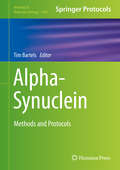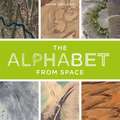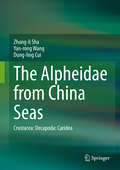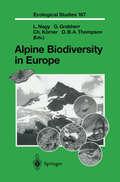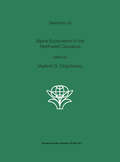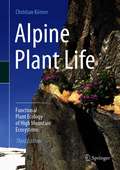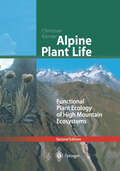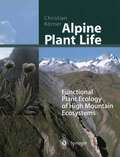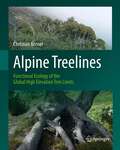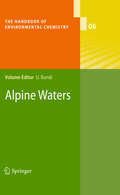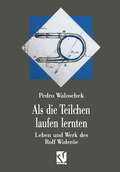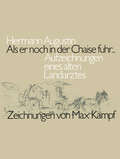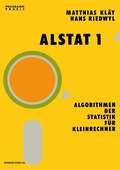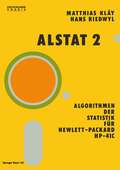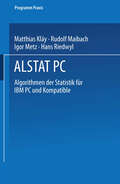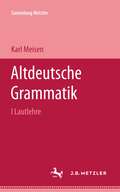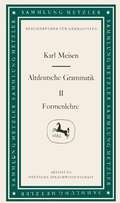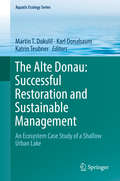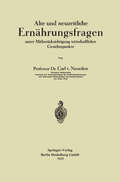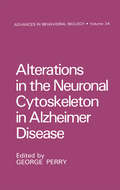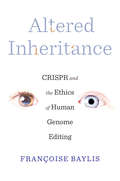- Table View
- List View
Alpha-Synuclein: Methods and Protocols (Methods in Molecular Biology #1948)
by Tim BartelsThis volume provides the reader with detailed protocols that describe a variety of in vitro and in vivo techniques that study reductionist systems and human samples. The methods covered in this book explore a broad selection of topics such as functional aspects of alpha-synuclein biology, its lipid-interactions and misfolding, and functional deficits in cells and mice. Chapters also cover topics such as kinetic measurements of endocytosis and exocytosis in cultured neurons; electrochemiluminescence-based detection; yeast-based screens to target alpha-synuclein toxicity; mass-spectrometry of alpha-synuclein in rat cortical neurons; and expression and purification of untagged a-synuclein. Written in the highly successful Methods in Molecular Biology series format, chapters include introductions to their respective topics, lists of the necessary materials and reagents, step-by-step, readily reproducible laboratory protocols, and tips on troubleshooting and avoiding known pitfalls.Cutting-edge and thorough, Alpha-Synuclein: Methods and Protocols is a valuable reference guide that aids researchers working on topics related to alpha-synuclein and its various aspects.
The Alphabet From Space
by Adam Voiland'Aloha, A! What begins with A? There is Antarctica, Azerbaijan, algal blooms, and alluvial fans. Astronauts appreciating awe-inspiring views of Earth from above. And these ancient Appalachian ridges in America intersected by an azure river in autumn!'We've all looked up at clouds and found faces, objects and animals within their white puffy shapes. Astronauts and satellites can do the same thing - but from far above in outer space...While working on a story about wildfires in northern Canada, NASA science writer and new father Adam Voiland found a stunning satellite image of an enormous smoke cloud, many miles across, shaped like the letter 'V'. The majesty of that image made Adam wonder: could he track down all 26 letters of the alphabet for his newborn baby son, using only satellite imagery and photographs of the Earth taken by astronauts? With the help of readers and colleagues at NASA, he started to collect images of clouds, blooms of sea plankton and dust storms that formed shapes reminiscent of all the letters from A to Z.The result is this beautiful book of earth imagery. It offers a unique view of the alphabet, where letters are spelled out by rivers, deserts, mountains and ice. At a time when Space travel is more popular than ever, and astronauts from Chris Hadfield to Tim Peake are inspiring a whole generation of young readers, this book is a delight for adults and children alike. It is at once a celebration of Space, language and the natural beauty of our home planet, and a gift to keep for ever.
The Alpheidae from China Seas: Crustacea: Decapoda: Caridea
by Zhong-li Sha Yan-rong Wang Dong-ling CuiAs one of the largest families within the Caridea, the Alpheidae have attracted much attention for its species richness, especially on coral reefs. The Alpheidae are one of the most abundant decapods in tropical and subtropical areas, with 48 genera and more than 700 known species. The Alpheidae present a particular challenge in terms of both taxonomy and systematics as they are difficult to identify (some species vary in their growth and there are often large differences between the sexes). Traditional, morphology-based research on the Alpheidae still plays an important role in identifying species, compared with new methods, such as the short gene sequences. Based on more than 2000 specimens collected from the China Seas, this book describes and clearly illustrates 146 species belonging to 16 genera of the Alpheidae. It also presents the key features of every genus and every species within every genus, to enable readers to easily identify the alphid shrimps of the China Seas.
Alpine Biodiversity in Europe (Ecological Studies #167)
by Laszlo Nagy Georg Grabherr Christian Körner Desmond B. A. ThompsonThe United Nations Conference on the Environment and Development (UNCED), held in Rio de Janeiro in 1992, spawned a multitude of pro grammes aimed at assessing, managing and conserving the earth's biological diversity. One important issue addressed at the conference was the mountain environment. A specific feature of high mountains is the so-called alpine zone, i. e. the treeless regions at the uppermost reaches. Though covering only a very small proportion of the land surface, the alpine zone contains a rela tively large number of plants, animals, fungi and microbes which are specifi cally adapted to cold environments. This zone contributes fundamentally to the planet's biodiversity and provides many resources for mountain dwelling as well as lowland people. However, rapid and largely man-made changes are affecting mountain ecosystems, such as soil erosion, losses of habitat and genetic diversity, and climate change, all of which have to be addressed. As stated in the European Community Biodiversity Strategy, "the global scale of biodiversity reduction or losses and the interdependence of different species and ecosystems across national borders demands concerted international action". Managing biodiversity in a rational and sustainable way needs basic knowledge on its qualitative and quantitative aspects at local, regional and global scales. This is particularly true for mountains, which are distributed throughout the world and are indeed hot spots of biodiversity in absolute terms as well as relative to the surrounding lowlands.
Alpine Ecosystems in the Northwest Caucasus (Geobotany #29)
by Vladimir G. OnipchenkoPlant geographical description of the area, syntaxonomy, spatial patterns, floristic richness, structure of plant communities in relation to soil properties and herbivore influence were described for a mountain region that is difficult to access. Seasonal, inter-annual, and long-term dynamics of vegetation are discussed on the base of long-term observations as well as pollen and phytolith analyses. Population biology of alpine plants is studied by combination of field observations and mathematical modelling. Plant population strategies and soil seed banks are described for alpine plants from several communities. Results of long-term ecological experiments (plant reciprocal transplantations, dominant removals, light limitation) showed the significance of competition and facilitation for community organization. Structure of soil algal and fungal communities is represented as well as mycorrhiza of alpine plants. Main animal groups (wild) history and modern nature conservation problems are discussed.
Alpine Plant Life: Functional Plant Ecology of High Mountain Ecosystems
by Christian KörnerThis book is a completely revised, substantially extended treatment of the physical and biological factors that drive life in high mountains. The book covers the characteristics of alpine plant life, alpine climate and soils, life under snow, stress tolerance, treeline ecology, plant water, carbon, and nutrient relations, plant growth and productivity, developmental processes, and two largely novel chapters on alpine plant reproduction and global change biology. The book explains why the topography driven exposure of plants to dramatic micro-climatic gradients over very short distances causes alpine biodiversity to be particularly robust against climatic change. Geographically, this book draws on examples from all parts of the world, including the tropics. This book is complemented with novel evidence and insight that emerged over the last 17 years of alpine plant research. The number of figures – mostly in color – nearly doubled, with many photographs providing a vivid impression of alpine plant life worldwide.Christian Körner was born in 1949 in Austria, received his academic education at the University of Innsbruck, and was full professor of Botany at the University of Basel from 1989 to 2014. As emeritus Professor he is continuing alpine plant research in the Swiss Alps.
Alpine Plant Life: Functional Plant Ecology of High Mountain Ecosystems
by Christian KörnerGenerations of plant scientists have been fascinated by alpine plant life - with the exposure of organisms to dramatic climatic gradients over a very short distance. This comprehensive text treats a wide range of topics: alpine climate and soils, plant distribution and the treeline phenomenon, physiological ecology of water-, nutritional- and carbon relations of alpine plants, plant stress and plant development, biomass production, and aspects of human impacts on alpine vegetation. Geographically the book covers all parts of the world including the tropics.This second edition of Alpine Plant Life gives new references, new diagrams, and extensively revised chapters.
Alpine Plant Life: Functional Plant Ecology of High Mountain Ecosystems
by Christian KörnerGenerations of plant scientists have been fascinated by alpine plant lifean ecosystem that experiences dramatic climatic gradients over a very short distance. This comprehensive book examines a wide range of topics including alpine climate and soils, plant distribution and the treeline phenomenon, plant stress and development, global change at high elevation, and the human impact on alpine vegetation. Geographically, the book covers all parts of the world including the tropics.
Alpine Treelines: Functional Ecology of the Global High Elevation Tree Limits
by Christian KörnerAlpine treelines mark the low-temperature limit of tree growth and occur in mountains world-wide. Presenting a companion to his book Alpine Plant Life, Christian Körner provides a global synthesis of the treeline phenomenon from sub-arctic to equatorial latitudes and a functional explanation based on the biology of trees. The comprehensive text approaches the subject in a multi-disciplinary way by exploring forest patterns at the edge of tree life, tree morphology, anatomy, climatology and, based on this, modelling treeline position, describing reproduction and population processes, development, phenology, evolutionary aspects, as well as summarizing evidence on the physiology of carbon, water and nutrient relations, and stress physiology. It closes with an account on treelines in the past (palaeo-ecology) and a section on global change effects on treelines, now and in the future. With more than 100 illustrations, many of them in colour, the book shows alpine treelines from around the globe and offers a wealth of scientific information in the form of diagrams and tables.
Alpine Waters (The Handbook of Environmental Chemistry #6)
by Armin Peter Christopher T. Robinson Bruno Schädler Bernhard Truffer Stefan Vollenweider Bernhard Wehrli Rolf WeingartnerMost of the world’s mountains are rich in water and, as such, play a pivotal role in the global water cycle. They provide water for diverse human uses and ecosystems. Growing water demands as well as climate change will lead to ever-increasing pressure on mountain waters. Overcoming water-use conflicts and maintaining the ecological functioning of mountain waters presents a highly challenging task and is indispensable for sustainable development.This book extensively portrays the highly diverse attributes of mountain waters and demonstrates their paramount importance for ecological and societal development. The extensive summaries on the scientific basics of mountain waters are supplemented with considerations on the diverse water uses, needs for management actions, and challenges regarding sustainable water management. This overview concerns not only the mountain areas themselves but also downriver reaches and their surrounding lowlands, and, therefore, the relationship between mountain and lowland water issues.
Als Arbeiterkind an die Uni: Praktisches für alle, die als Erste/r in ihrer Familie studieren (essentials)
by Katja Urbatsch Evamarie KönigKatja Urbatsch und Evamarie König liefern in diesem essential praktische Informationen für diejenigen, die darüber nachdenken, als Erste in ihrer Familie zu studieren, oder bereits mit dem Studium begonnen haben. Sie erläutern die typischen Herausforderungen für Studierende der ersten Generation und zeigen Unterstützungsmöglichkeiten und Lösungswege auf. Mit der gemeinnützigen Organisation ArbeiterKind.de begleiten die Autorinnen beruflich Schülerinnen und Schüler sowie Studierende aus Familien ohne Hochschulerfahrung. Daher kennen sie die typischen Fragen und Sorgen, die von Leistungsanforderungen über Studienfinanzierung bis hin zu Berufsperspektiven reichen.
Als die Teilchen laufen lernten (pdf): Leben und Werk des Großvaters der modernen Teilchenbeschleuniger — Rolf Wideröe
by Pedro WaloschekAls die Welt still stand: Galileo Galilei - verraten, verkannt, verehrt
by Atle NaessDie preisgekrönte Biographie des norwegische Schriftstellers Atle Næss führt den Leser auf eine fesselnde Reise durch die Höhen und Tiefen des Lebens einer der schillerndsten Persönlichkeiten der europäischen Wissenschaftsgeschichte - Galileo Galilei. Mit feinsinniger Empathie entwickelt Naess das Portrait eines Mannes, der sich selbst durch die Zwänge der römischen Inquisition nicht von seinen wegweisenden Forschungen abbringen ließ. Aus den Rezensionen der norwegischen Ausgabe: "Mit umfassender Kenntnis und sicherem Erzählstil hebt Næss die epochemachenden Arbeiten hervor, die die Grundlage der modernen experimentellen Naturwissenschaften bilden. Er packt all die vielen Stationen [Galileis] Lebens in ein sehr lesenswertes Buch, das in vielerlei Hinsicht hervorsticht." Per Anders Madsen, Aftenposten Morgen "Diese Biographie stellt eine faszinierende kulturhistorische Studie dar und ist daher nicht nur für Leser mit Interesse an Naturwissenschaft und Wissenschaftsgeschichte geeignet. Sie kann auch hervorragend als Roman gelesen werden." Atle Abelsen, Teknisk Ukeblad
Alstat 2 Algorithmen der Statistik für Hewlett-Packard HP-41C (Programm Praxis #2)
by Kläy Riedwl7 0 INHALT EINLEITUNG 9 1 2 ALLGEMEINER AUFBAU 11 2.1 TECHNISCHE VORAUSSETZUNGEN 11 2.2 GEMEINSAME STRUKTUR DER PROGRAMME 11 11 2.2.1 Aufbau des Tastenfe1des 2.2.2 Grundrechner-Funktionen 17 2.2.3 Kontro11funktionen 18 21 2.2.4 Eingabefunktionen . 2.2.5 Variab1en . 21 21 2.2.6 Statistikfunktionen 2.3 FEHLERBEHANDLUNG 22 23 2.4 DIE TRANSFORMATIONSROUTINE TRA 24 2.5 FORMAT DER FUNKTIONSBESCHREIBUNGEN 2.6 ZU DEN BEISPIELEN . 25 26 3 STAT1 PROGRAMMBESCHREIBUNG 3.1 DAS TASTENFELD 26 29 3.2 FUNKTIONSBESCHREIBUNGEN . 3.2.1 Kontro11funktionen 29 30 3.2.2 Eingabefunktionen . 3.2.3 Variab1en . 32 3.2.4 Statistikfunktionen 33 3.3 BEMERKUNGEN . 35 3.3.1 Masszah1en 35 3.3.2 Extremwerte . 35 3.3.3 Der Stack. 36 3.3.4 Transformationen 36 36 3.3.5 Histogramm 3.3.6 Hinweis zum a11gemeinen Gebrauch 37 3.4 FEHLERLISTE . 38 3.5 BEISPIELE . 39 LINMOD PROGRAMMBESCHREIBUNG . 51 4 4.1 DAS TASTENFELD 51 4.2 FUNKTIONSBESCHREIBUNGEN . 54 4.2.1 Kontro11funktionen 54 54 4.2.2 Eingabefunktionen . 4.2.3 Variab1en . 56 4.2.4 Statistikfunktionen 56 59 4.3 BEMERKUNGEN .
ALSTAT PC: Algorithmen der Statistik für IBM PC und Kompatible (Programm Praxis #7)
by Kläy Maibach Metz RiedwylThe Alte Donau: An Ecosystem Case Study of a Shallow Urban Lake (Aquatic Ecology Series #10)
by Martin T. Dokulil Karl Donabaum Katrin TeubnerHere we report on a 25-year long-term sequence of measures to return a deteriorated recreational urban lake, Alte Donau in Vienna to acceptable water quality. Metropolitan waters require focused ecosystem management plans and intensive in-lake efforts. We explored physico-chemical conditions, food web from viruses to fish and water birds, the sediments, the littoral zone and the catchment, management and urban planning, and global warming. Several restoration techniques were tested and critically evaluated. The final management plan was based on bi-stable theory. During the recovery phase, numerous surplus adjustments had to be implemented to secure sustainable achievement.
Alte und neuzeitliche Ernährungsfragen: unter Mitberücksichtigung wirtschaftlicher Gesichtspunkte
by Carl von NoordenDieser Buchtitel ist Teil des Digitalisierungsprojekts Springer Book Archives mit Publikationen, die seit den Anfängen des Verlags von 1842 erschienen sind. Der Verlag stellt mit diesem Archiv Quellen für die historische wie auch die disziplingeschichtliche Forschung zur Verfügung, die jeweils im historischen Kontext betrachtet werden müssen. Dieser Titel erschien in der Zeit vor 1945 und wird daher in seiner zeittypischen politisch-ideologischen Ausrichtung vom Verlag nicht beworben.
Alterations in the Neuronal Cytoskeleton in Alzheimer Disease (Advances in Behavioral Biology #34)
by George PerryThe neuronal cytoskeleton is a complex structure responsive to both intrinsic and extrinsic factors. Defined populations of neurons in the brains of patients with Alzheimer and several other neurodegenerative diseases contain abnormal filamentous accumulations which share elements with the cytoskeleton. Although there is a general consensus that these abnormal filaments do contain cytoskeletal elements, much debate remains regarding which cytoskeletal elements are incorporated and whether the cytoskeletal rearrangement is primary or secondary to other cellular changes. In this book these questions are addressed in a historical perspect ive in light of new data that allows the reinterpretation of previously reported results. Contributions are based on many of the major tech niques of modern biology including biochemistry, molecular biology, electron microscopy and immunocytochemistry. In the view of the editor, this volume is being written at a time when our understanding of the cytopathology of Alzheimer disease is moving from predominantly descriptive to both analytical and mechanistic. I hope that this contribution will provide impetus to speed this transi tion. George Perry Cleveland, Ohio vii ACKNOWLEDGEMENT The support of the Fidia Pharmaceutic Corporation for the computer generated color figure on page 65 is gratefully acknowledged.
Altered: An Altered Saga Novella (Altered #1)
by Jennifer RushThey were made to forget. But they'll never forgive.Everything about Anna's life is a secret. Her father works for the Branch, at the helm of its latest project: monitoring and administering treatments to the four genetically altered boys in the lab below their farmhouse. There's Nick, solemn and brooding; Cas, light-hearted and playful; Trev, smart and caring; and Sam . . . who's stolen Anna's heart.When the Branch decides it's time to take the boys, Sam stages an escape. Anna's father pushes her to go with them, making Sam promise to keep her away from the Branch, at all costs. On the run, with her father's warning in her head, Anna begins to doubt everything she thought she knew about herself. She soon discovers that she and Sam are connected in more ways than either of them expected. And if they're both going to survive, they must piece together the clues of their past before the Branch catches up to them and steals it all away.
Altered Inheritance: CRISPR and the Ethics of Human Genome Editing
by Françoise BaylisWith the advent of CRISPR gene-editing technology, designer babies have become a reality. Françoise Baylis insists that scientists alone cannot decide the terms of this new era in human evolution. Members of the public, with diverse interests and perspectives, must have a role in determining our future as a species.
Altered Metabolism: A Major Contributor of Comorbidities in Neurodegenerative Diseases
by Namita AgrawalThis book presents a systematic and extensive understanding about metabolic alterations affecting multiple aspects of different neurodegenerative diseases (NDDs), such as Alzheimer’s, Parkinson’s, Huntington’s disease, SCAs, SBMA, DRPLA, ALS, Freidrich Ataxia etc. The book also illustrates cellular and molecular mechanisms behind the key neurodegenerative diseases and further expands on concept of unique and developing biomarkers associated with the onset and progression of NDDs. Additionally, it elaborates on the concept of latest imaging tools to monitor state of NDDs and accordingly develop therapeutic approaches entailing phytochemicals in the management of metabolic alterations associated with NDDs that ultimately suppresses course of devastating NDDs. The book aids to improve the overall understanding about the NDD and involvement of metabolic disorder as a major factor for indisposition of the disease. Therefore, suggesting that targetting metabolic variations by phytochemicals can combat NDD related symptoms for the betterment of impacted patients. While introducing cellular and molecular mechanisms and the treatment regimen under the umbrella of metabolism in several NDDs, the book covers major aspects of understanding the metabolic basis of NDDs, its implications, and treatment. This will inflate the readers' understanding about this particular area and guide those working in this domain, be it a researcher or clinicians,to choose or design effective therapeutic strategies to curb metabolic alterations linked with these disorders. This book will not only contribute towards improving the overall state of the challenged individuals but will also bring new hope towards improving the quality of lives of affected patients.
